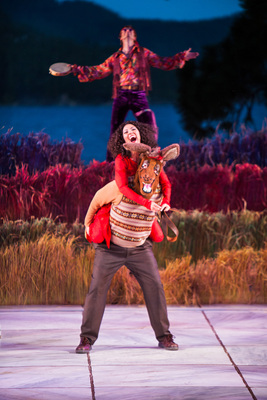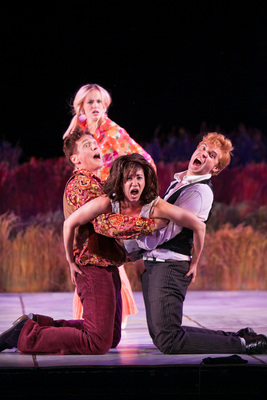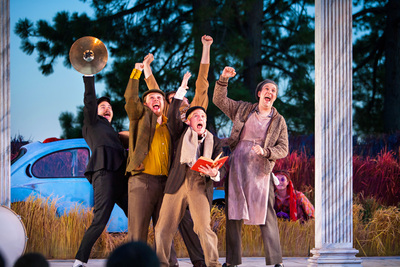Review: A MIDSUMMER NIGHT’S DREAM at the Lake Tahoe Shakespeare Festival
August 5, 2013 § Leave a Comment
What A Concept!
Because from the second I heard of it, I loved Charles Fee’s concept for a “1960s” production of A Midsummer Night’s Dream at the Lake Tahoe Shakespeare Festival, I was in high hopes that I would love the production. As it happens, I did love parts of it a LOT, just not for reasons that had much to do with the concept.
I was excited about the way a 60s setting could emphasizing the generation gap at work between the young lovers and the older blocking figures of the Athenian court, and intrigued by the promise that the fairies in the woods would have an Indian flavor (appropriate to the text of the play), in keeping with the celebrity consciousness-raising pilgrimages to India of the time. It seemed to me the whole “Age of Aquarius” vibe might be perfect for this play which is, you know, about freedom and love, man. In many ways, the concept has the potential to be genuinely enlightening about the play. Unfortunately, little of that potential was ultimately realized, because the exploration of the 60s zeitgeist was so superficial.
Some moments did delivered on the concept: The rustics become Bohemians that arrive in a Volkswagen covered with flower power graffiti, and eventually performed their interlude with a drum that literally identified them as “Sergeant Pepper’s Lonely Hearts Club Band.”
Help!
The primary means of setting the 1960s tone was the addition of a great deal of Beatles music, which was simple played over the loudspeakers as a musical score. (The director’s note indicates his interest in the “British invasion” but I heard nothing from any other band.) This might have been a very clever idea had it been executed better. Unfortunately, however, the music often seemed imposed because of a correspondence to a word or two of the lyrics to the traditional text, rather than an overall situational correspondence. At the moment when Bottom is transformed into an ass, and the traditional text has his fellow workers running about in panic, in this production their dialogue was cut in favor of playing the Beatles song, “Help!” That was funny for exactly one word, but the song kept playing and the incongruity of hearing, “Help, I need somebody. Help, not just anybody…” grated. Such gaffes happened over and over in the course of the evening, as if the director believed no one in the audience had ever heard the music of the Beatles before and would have no idea that the songs are actually about something quite different than the use to which they were being put.
The traditional text was heavily cut in order to make room for the musical additions. It is not uncommon for theatrical productions to trim Shakespeare’s texts, of course, but in this case the extensive musical substitutions ate up valuable time, while providing less information. Some scenes were even added to the play (in mime), such as Hermia’s sneaking out of her home at dawn, simply so that a famous tune could be played. That hurt when you started missing some of the great speeches of the play just to hear a recording.
One Out of Three Ain’t Bad
Midsummer Night’s Dream, famously, has three plots. Fee’s production found almost nothing of interest in the first of these, the story of the four young lovers. He conceived them not as the freedom-seeking, idealistic youth of the 60s, (which would have been the perfect application of his concept to the play) but as shallow, trendy wanna-bes who don’t quite get it. They were, weirdly, viewed from the older generation’s perspective.
Gracyn Mix’s reading of Helena’s gorgeous soliloquy, “Love looks not with the eyes, but with the mind,” was performed in such an airheaded manner that it was impossible to take the meaning seriously, which is too bad since it is the play’s thematic core. Brad Standley’s Lysander was smugly self-involved, and it was hard to see his appeal, except in comparison to Christian Durso’s deliberately repellant Demetrius. Lori McNally as Hermia brought the most dimension to her character of the four, but even then it was the first time I have ever found myself in sympathy with her repressive father Egeus’ opinion that teenagers should not be allowed to make decisions about love for themselves, because they make them so badly.
It is unfair to blame the obviously well-trained and earnest actors since their every movement, reaction, and line reading seem heavily imposed from a directorial perspective. Although occasionally clever, the actions so lacked spontaneity that the actors ultimately devolved into puppets that we cared nothing about.
Theseus and Hippolyta were little better. The tension between them in the play’s opening appeared to set the stage for a dark reading of the play, but that tone was immediately forgotten upon Hippolyta’s first exit, and never revisited (or explained).
Oberon and Titania, doubled by the same actors playing Theseus and Hippolyta (Mic Matarrese and Carie Kawa), were more engaging, but deprived of their trains – by budgetary limitations instead of aesthetic considerations I fear – their quarrel seemed specifically personal to them and vaguely irrelevant to us. Even in the best of productions, it is hard to make clear to an audience the substance of their quarrel over a changeling boy, but in this production the perverse decision to have Puck mime a discus-like ejecting of the invisible child at his first mention compounded the problem. I can’t imagine that the director intended this as an instruction to ignore this messy plot complication since it is the central conflict, but no other interpretation seems immediately available.
 Photo by Joy Strotz
Photo by Joy Strotz
And Now, the Star of Our Show…
Speaking of Puck, the oddity at the heart of this production is that it conceived of him as the central character. The company’s perennial comedian, Jeffrey C. Hawkins, played the role with genuine star power. He is a gifted physical comedian, and a pretty good mimic, with the manic energy reminiscent of Robin Williams. He kept the show moving, and provided a great deal of comic delight in his own way, even if his Morkesque-style was more 70s than 60s. Nonetheless, the play was dangerously unbalanced by building the entire production around this peripheral character. This destabilizing began with Puck’s very first scene, which eliminated the fairy with whom he has a dialogue in the text, and turned it into a standup monologue. It continued all the way to the end of the show when the traditional blessing masque was entirely eliminated in favor of foregrounding Puck’s final speech as a stand-alone bookend to his opening monologue. Although he serves to complicate it, Puck has no real investment in the action of the play, and making it all about him means that nothing is at stake.
It Sure Is Pretty Here
 Photo by Joy Strotz
Photo by Joy Strotz
For all its shortcomings however, this production had some obvious strengths that ultimately carried the evening. The first of these was the beautiful, as well as very functional, scenic design by Gage Williams. As with most productions of A Midsummer Night’s Dream, we entered to see a classically Greek colonnade in front of a marble back wall. At the end of the first act when the action moved to the woods, the entire back wall opened up to reveal the vista across Lake Tahoe with only a psychedelically multicolored reed groundrow at the back edge of the stage. It was a brilliant marriage of minimal scenery and natural setting. The costumes by Star Moxley were appropriate to the period, as well as witty selections from the 1960s wardrobe. The Eastern robes of the fairies were particularly inspired, with their gorgeous draping and elegant flow. Rick Martin’s lighting design kept our eyes where they needed to be, without overpowering the natural background that made the evening spectacular.
Bottom and Our Gang
It would have been a difficult, even failed, evening if the only highpoint had been the spectacle. This was a production that soared upon the entrance of the rude mechanicals, however, in that beat-up VW bug. They were endlessly inventive, and downright hilarious in their roles as would-be actors. Half-dressed and obviously tripping, they later became the fairies surrounding Bottom and Titania, which was not just guffaw-inducing, but interpretively enlightening.
Their byplay in the woods provided genuine levity, but their performance of the (admittedly foolproof) play-within-a-play in the final act was as funny as I have ever seen it. Shad Willingham brought hearty charm to Bottom’s extroversion, and the same engaging physicality previously seen in his transformation into an ass. Dustin Tucker was hysterical as Peter Quince, reveling in his role as director. Jo Atack as Snout the tinker and Sonny Valicenti as Starveling the tailor kept up although their parts are small.
As happens in almost every production of A Midsummer Night’s Dream, teenage Flute reluctantly taking on the female role of Thisbe in the play-within-the-play stole the show. Ryan David O’Bryne was a skipping, tripping revelation as he started getting “naturally high” on being in the limelight.
The biggest surprise was Wesley Gaines McNair’s touching, highly original interpretation of Snug the joiner. Instead of playing the character as dense, McNair’s found in him a debilitating shyness. His portrait of the Lion – who frightened only himself – in front of the Duke brought sighs of “Ahhhhhhhh” from the audience, and explained (for once) the Duke’s change of heart from contempt for the superficial playing to sympathy for the earnest efforts of the sincere, if incompetent, amateur performers.
Although almost always funny, the fifth act of this production was so relentlessly delightful that the entire evening was redeemed. I remained a little perplexed about the intent of the 1960s concept, however, even through the majority of the final scene. The intended payoff only became clear at the very last moment of the evening when the Duke and Duchess, and the four young lovers, had departed the stage leaving behind only the curtain before which the rustics had played. Then, in a gorgeous backlit image, we suddenly got the silhouette of the Fab Four and over the loudspeakers we heard, “Love, Love, Love.” If only the production that had preceded it had actually had more to say about love it might have been the cleverest idea ever.


Leave a Reply